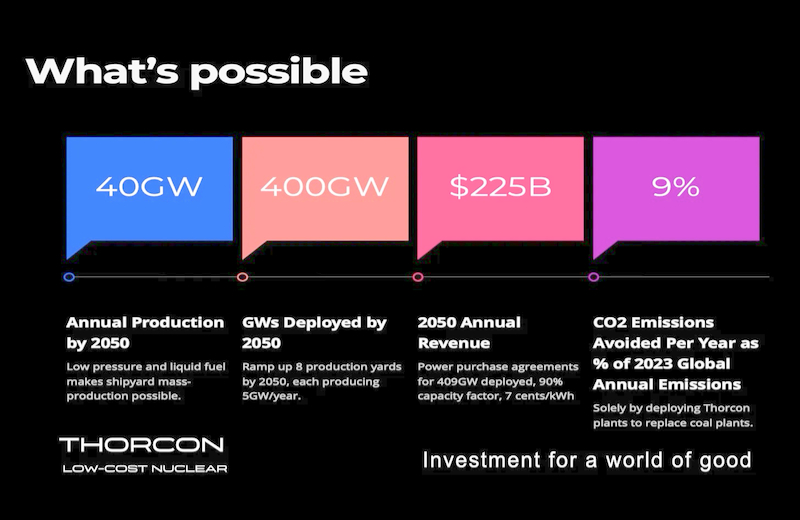We've recently added two dynamic individuals to our SCGI advisory group: Van Snyder and Robert Hargraves. Both of them have been producing thought-provoking articles on energy systems—particularly nuclear power—for years. And both have recently published books on the subject.
A world of good
By Dr. Robert Hargraves
Amazon, Google, and Microsoft just committed billions of dollars to power their data centers with ample, reliable electricity from nuclear power. These competitors realize they must provide more energy-intensive computing for artificial intelligence and information search services. Each, with over $100 billion cash on hand, can afford whatever it costs in this competition. Will this make nuclear power globally affordable?
Beyond such services industries, energy is an essential component of the $40 trillion global production sector — agriculture, industry and manufacturing. These activities have achieved low costs through decades of improvements in uses and costs of energy from burning fossil fuels. People in rich nations benefit from the inexpensive food, affordable transportation, and powerful smartphones.
Only LOW COST nuclear power will impact our future.

Most of the world’s people are not in the rich nations. Leaders of aspiring people in developing nations must choose the lowest cost, reliable energy sources to advance their industries and economies. They now build full-time, coal and LNG power plants. Rectifying energy poverty while reducing climate-altering CO2 emissions requires ample, emission-free, reliable energy.
Nuclear power can help the rich tech firms, but not the developing nations unless it’s low cost. New nuclear power must be lower cost than from burning coal and petroleum fuels.
Thorcon low-cost nuclear design choices
Thorcon focuses on low costs because improving global prosperity and climate depends on selling thousands of reliable, emission-free electric power plants in place of fuel burning plants. Cost matters. Scale matters. Coal is the competitor. Only wide-scale, low-cost nuclear power will impact our future.
Thorcon has designed a shipyard-produced, uranium-fissioning, molten-salt reactor with supercritical steam-turbine electric power plant. Why this technology choice? Low cost! Here are Thorcon's resulting design choices.
Low cost liquid fuel form. Uranium is dissolved in stable, molten salt. Liquid fuel does not require precision fabrication of millions of fuel pellets in tens of thousands of zirconium clad fuel rods in hundreds of fuel assemblies as do pressurized water reactors. Nor does liquid fuel require producing billions of sand-size, triple-wrapped uranium fuel particles bound in hundreds of thousands of billiard ball shapes in some reactor types.
Low cost molten salt. Molten salt is simply pumped in stages to transfer fission heat energy to the supercritical steam turbine-generator. Mixed beryllium and sodium fluoride salts have a large liquid temperature range, 480-1430°C, providing high temperature tolerance in operating and accident conditions. Thorcon molten salt contains low-cost sodium rather than expensive, isotopically enriched lithium-7.
Low cost corrosion protection. High purity molten salts and chemical redox control result in long life for molten salt systems made of 316 stainless steel. This metal is competitively sourced and readily fabricated, minimizing use of Hastelloy or other expensive metals.
Low cost uranium. Standard, 5% uranium-235 enriched fuel is commercially procured as uranium hexafluoride (UF6) in standard canisters shipped from commercial enrichment plants. Thorcon converts it to UF4 dissolved in molten salt. There is no need for more expensive, commercially unavailable, high assay low enriched uranium (HALEU) with 20% uranium-235.
Low cost low pressure. Common commercial reactors pressurize water to 155 times atmospheric pressure (155 bar) to keep water liquid at 315°C to transfer enough reactor heat energy. Thorcon molten salt transfers heat at low pressure, reducing costs for its manufactured vessels, tanks, pipes, and pumps. Low pressure obviates any need for an expensive, reinforced concrete dome that pressurized water reactors use to contain an accidental water-to-steam explosion propelling radioactive materials.
Low cost hot heat. ThorCon’s molten salt delivers hot, 704°C heat, much hotter than the 285-315°C water-transferred heat of today’s commercial and tomorrow's small modular reactors. Thorcon hot heat produces 550°C steam at 250 bar pressure. Such supercritical steam powers modern supercritical steam turbines in new coal-fired plants. Thorcon plants have 46% efficient conversion of heat to electricity, while conventional reactors are only 33-35% efficient. This reduces fuel consumption and cooling water use by nearly half.
Low cost 500 MW size. Economy of scale led to two 557 MW thermal fission reactors powering a single 500 MW electric steam turbine-generator. Such supercritical steam turbine-generators are standard for new coal-fired power plants, so they are competitively priced and nearly off-the-shelf commercially. Today’s and tomorrow’s pressurized water reactors use more expensive, special order, lower temperature turbine-generators.
Thorcon's 500 MW unit is not ’small’ nor ‘large' but optimized for low-cost electricity. Each unit is standardized for repetitive production. Larger power plant sites with multiple 500 MW units continue these low cost benefits.
Low cost shipyard construction. Thorcon 500 has the same structural design as a double-hull oil tanker. Low costs result from standard shipyard steel construction techniques and expertise. The plant's 65 meter beam fits in the docks of competing, high efficiency shipyards. The industry traditionally deals in fixed price contracts. Two-year build times reduce political risk and lower construction works in progress costs. Site preparation delays simply mean Thorcon 500s are shipped to other locations.
Low cost siting. Shipyard fabrication eliminates costs to import cadres of skilled construction workers to each nuclear power plant site. A complete Thorcon 500 power plant is moved by sea from shipyard to site, not constrained to module sizes suited to land transport. Shoreside siting enables low cost seawater cooling for steam turbine condensers.
Low cost personnel. A traditional 500 MW pressurized water nuclear plant requires approximately 500 personnel. Thorcon 500 plant operators are not important to safety. Intrinsic, passive safety eliminates costs for highly trained plant operators entrusted to prevent radiation releases. A staff of 179 suffices to operate the plant full time.
Robert Hargraves, cofounder, thorconpower.com
